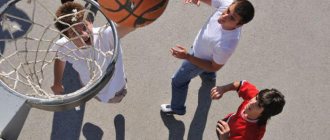How to tell children about the rules of safe behavior on the street
Be an example The first and most important thing: in the presence of a child, parents themselves must strictly observe the safety rules that they practice with their son or daughter. As an example: you should not cross the road at a red light, run into the closing doors of a vehicle with your child, or take a shortcut by passing through construction sites. And under no circumstances should you violate this principle by explaining it as haste, “one time”, and so on.
Let's not leave him alone The child does not have enough life experience that can tell him how to behave in a new, unfamiliar environment. Therefore, naturally, you cannot leave him alone. It is necessary to talk through any situation that is new to the child, especially a conflict or traumatic situation. You must be patient when answering numerous children's questions, repeating over and over again the rules of behavior that you want to teach.
Choosing words It is extremely harmful to use phrases like: “If you behave badly, a policeman (evil uncle, robbers, etc.)”, “Now I’ll go home, and you’ll stay here!” From these phrases, the child does not gain any new experience or information, but only concludes that he can be given to someone or left for nothing. He loses his sense of safety, security, and importance for his parents.
Also, you should not use explanations like: “bad”, “bad”, “not good”. These are too abstract concepts that don’t tell a child anything. We must try to explain why it is bad to do this or that way and what dangerous consequences this or that method of behavior may have.
Be patient When talking about safety, you should avoid overly negative emotional overtones. Due to psychological characteristics, the child will create a hopeless-catastrophic picture in his mind.
Conversations about safety should be carried out in the form of a regular conversation that accompanies the daily joint activities of the child and the parent, for example at an intersection: “Do you see the red man? He stands and we stand. And now it’s green, it looks like it’s walking, which means we can cross the road too.”
Games and poems are used. To reinforce information, you can use rules set out in poetic form, for example: “Red light - no road, yellow - get ready, and green says: go ahead, the path is open!”
Children learn about the world through play, when they try on different roles and play out different life events. To assimilate and remember, you should use games that play out potentially dangerous life situations. Such games of “life” are a great way to teach your child about the basic principles of safety, and together with him to find optimal and safe ways to get out of such situations.
It is very convenient to explain traumatic situations in such a playful form: behavior near construction sites, pits, open wells and windows, railway tracks, not forgetting to draw the child’s attention to this on the street whenever possible. zzzz
All of the above works provided that parents are interested in the safety of their child, patiently answer all children's questions and do not brush them aside. And they treat the process of education as a guarantee of their well-being, and not as a burden that prevents them from going about their business.
A balanced emotional state of a parent is the key to ensuring that the child will be open to accepting new information. In such a state, you can explain to him how he can behave and how he cannot. Feeling safe, the son or daughter will not be afraid and will not be injured.
Also, we should not forget about interactive programs, cartoons and children's literature dedicated to safety issues. Using these materials in the process of joint activities with children.
“Parents play the main role in shaping the rules of safe behavior. They are the ones who are responsible for the physical and psychological safety of their children, since by definition they are the main significant people for the child,” says Alexander.
Children's Art School No. 6
The main thing that children should know is that safe games are possible only on a specially equipped playground. The task of parents is to monitor the absence of dangerous objects and the serviceability of the equipment, teach children the rules for using it, explaining along the way how not to play :
To review the material, do a practical exercise . Discuss the proposed options with the children and choose which child chose a safe place to play (there may be several correct answers):
Cars deserve special attention. It's no secret that many courtyards have been turned into surface parking lots - this is an additional source of danger:
- cars can drive into the playground - we urge parents to stop these offenses by all legal means
- a child may be in a hurry to go home or to the playground and not notice a car driving along the yard - teach children not to rush, set the right example with your own behavior
- there may be parked cars near the entrance blocking the view of the roadway - this is also an offense, but parents also need to be vigilant and teach children to carefully inspect the roadway in order to notice a moving car, motorcycle, or bicycle in time
And, of course, we ask, first of all, the parents-motorists themselves not to create emergency situations in the yard!
To review the material, do a practical exercise . Look at the picture and discuss why there is a threat to the safety of children in the circled areas, ask your child to explain how these dangers can be avoided:
A special place in the conversation about personal safety should be given to leaving the house :
- before leaving the apartment (house), look through the peephole and make sure that there are no strangers on the site (near the door), otherwise wait;
- never enter an elevator with strangers, as well as into an entrance or landing if there are suspicious people standing there, especially a group of people;
- if you are attacked in the elevator, try to press the “Call dispatcher” button, but do not shout, especially in cases where you are not sure that there are people nearby who can help;
- Never, under any circumstances, get into a car, motorcycle, or helicopter with strangers!
If a child walks in the yard on his own, he needs to know several rules of safe behavior :
- stay away from teenagers who are older than you, are under the influence of alcohol or drugs, gamble or behave inappropriately
- do not take expensive things (cassette recorder, toys, tablet and other gadgets) outside if there are no elders near the house
- do not carry valuables or money with you
- do not climb in basements, attics and roofs
- when walking on the street, try to stay close to your home, be in familiar company (the last condition is mandatory if you go far from home, especially to a foreign area, to a disco, market, store, concert - in this case, you need adults to know , where are you at)
- a call for help is not evidence of cowardice, but a necessary means of self-defense, sometimes salvation
- if you are trapped - there are more attackers, they are clearly stronger, there is no one nearby who could come to the rescue - then it is better to give the money or the thing that they demand, remember that your life and health are most valuable
- if they start following you, go (run) to where there are a lot of people, there is more light (at night)
- never gamble, especially for money, with older children or adults, or with strangers in general
- In order to prevent kidnappings, it is necessary to:
- try not to be alone, especially on the street, on the way to school and back, from places of leisure;
- change your routes to school, the store, to friends, etc. more often.
- never talk to strangers, much less suspicious people;
- do not get into other people's cars, do not ride with strangers;
- always inform your relatives about where and when you are going, with whom, how long and where you are going to be, when and in what way you are going to return (if possible, provide your phone number and other coordinates where you can be found).




